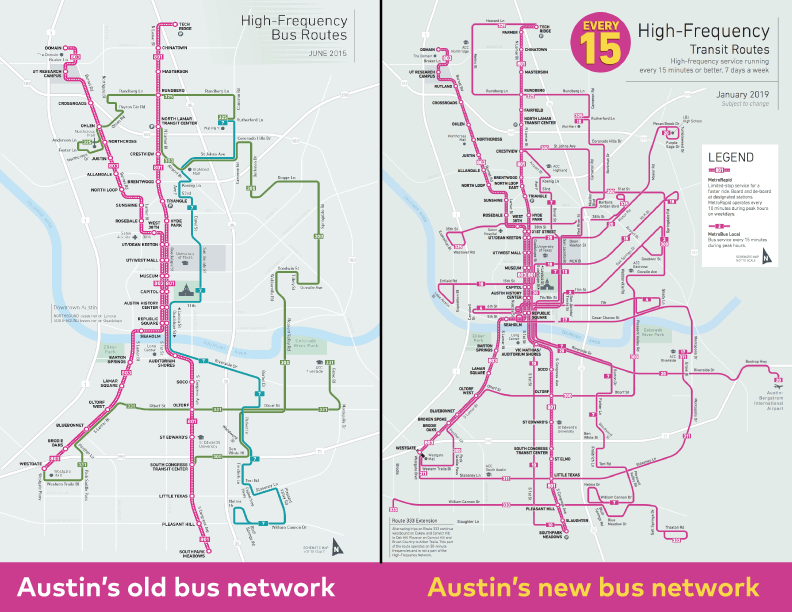
In June of 2018, Austin launched a redesign of its bus network. Since then, ridership has increased 4.5%, making Capital Metro one of the few transit systems in the U.S. where ridership is on the rise.
The success of the network redesign, known as Cap Remap, was the result of careful planning and preparation. Capital Metro was meticulous in the run-up to launch, conducting extensive outreach to convey the changes to bus riders, and helping bus operators in their role as frontline messengers for the redesign.
Another key to success: Cap Remap added service — it was not a revenue-neutral network redesign.
Dottie Watkins, Vice President of Bus Operations at Capital Metro, describes the core concept of Cap Remap as “meeting the community where the transit demand is.” Access to frequent transit — the number one priority for Austin transit riders surveyed before the redesign — is now much more widespread.
Capital Metro also dramatically improved bus service on weekends. Historically, says Watkins, it’s “been hard for Austin households who work Saturdays and Sundays to give up a second car if transit only works for you on some [days of the week].”
Cap Remap reallocated service so more routes run at least every 15 minutes from 6 a.m. to 8 p.m., seven days a week. The number of these high-frequency, all day, every day routes increased from 6 to 14.
When Capital Metro embarked on a bus network redesign, the plan was to stay budget neutral. However, without an increase in service, the options were either an expanded network of high-frequency routes that significantly sacrificed service in lower-ridership areas, or a scaled-back frequent network that preserved existing coverage.
Neither option was acceptable. Capital Metro and its board didn’t want to give up on the high-ridership, frequent network model. At the same time, they wanted over 98% of current transit riders to remain within a quarter-mile of service.
The solution, made possible by growing sales tax revenue, was to add resources for operations. Capital Metro increased service by 9% as part of the redesign. With this net addition of service, cutting some low-ridership routes became more politically feasible. The agency also had greater leeway to proceed with other changes, like consolidating bus stops.
Changing the network so dramatically meant that a majority of Austin bus riders experienced some sort of change in their travel pattern – anything from a bus stop that was moved to a trip that now requires a transfer to reach one’s destination. This required a lot of communication with riders to reassure them that their total travel time would be reduced even if their trip involved an additional transfer.
A year into the new network, the effort is paying off. Capital Metro passenger feedback about the redesign has primarily been positive, and Watkins sees the ridership increases as a vote of confidence.
Capital Metro promises riders that these frequent routes will adhere to 15-minute headways, de-emphasizing clock-based schedules. “What customers want is not to have to plan their life around some obscure bus schedule,” said Watkins.
What customers want is not to have to plan their life around some obscure bus schedule
Capital Metro is still refining its service management plan to minimize bus bunching and gapping as they occur in real time. “As an industry we’re talking about increasing our frequent services,” said Watkins, “but the way operationally you handle a service that’s primarily being promoted based on its headway as opposed to its schedule is different.”
The bus network redesign also involved coordination with the city of Austin. Cap Remap called for street changes to prioritize transit and walking, including pedestrian improvements at key transfer points in the new network. Capital Metro had been requesting some of these changes for years — the large scope of the redesign prompted action.
Crucially, the coordination is continuing. Capital Metro and the city of Austin convene a working group on a regular basis to discuss opportunities for on-street transit priority. Those are the types of changes Austin needs to keep improving service and growing ridership.
 On the Brink: Will WMATA’s Progress Be Erased by 2024?
On the Brink: Will WMATA’s Progress Be Erased by 2024?
The experience of being a WMATA rider has substantially improved over the last 18 months, thanks to changes the agency has made like adding off-peak service and simplifying fares. Things are about to get even better with the launch of all-door boarding later this fall, overnight bus service on some lines starting in December, and an ambitious plan to redesign the Metrobus network. But all of this could go away by July 1, 2024.
Read More A Bus Agenda for New York City Mayor Eric Adams
A Bus Agenda for New York City Mayor Eric Adams
To create the “state-of-the-art bus transit system” of his campaign platform, Mayor Adams will have to both expand the quantity and improve the quality of bus lanes. We recommend these strategies to get it done.
Read More